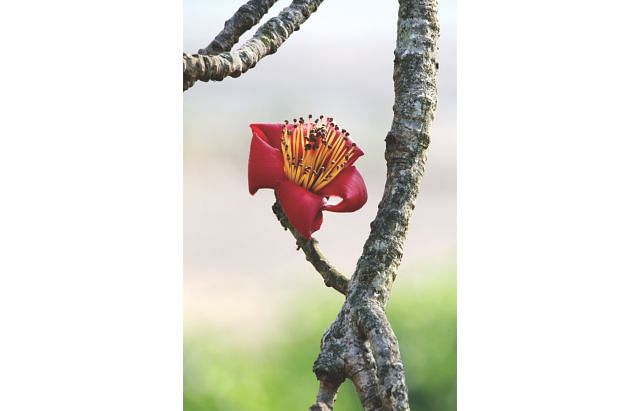The Generous Shimul
 Shimul (silk cotton or bombax ceiba) flower. Photo:Ihtisham Kabir
Shimul (silk cotton or bombax ceiba) flower. Photo:Ihtisham Kabir
Spring and summer bring my favourite quintet of flowers: shimul, krishnachura, jarul, shonalu and mandar. Of these, shimul (silk cotton, bombax ceiba) is perhaps the most fleeting, arriving the earliest and departing quickly.
By mid-February, the deciduous shimul trees have shed their leaves and the first flowers appear. The bare trees covered in bright red catch your eyes from afar, perhaps at the edge of a large rice field or towering over a grove of smaller but greener trees in a village.
While most shimul flowers are red, I have also seen orange and yellow shimuls.
The tree itself has conical shaped thorns on the trunk which diminish with age. The branches emerge radially from the trunk, usually in a spiral pattern. In full bloom, the flower is large – a six-inch diameter is common – and consists of five thick, fleshy petals with an oily or satin sheen. After the flowers, fruits appear in the form of seed pods containing fluffy cotton, which may be commercially harvested as “shimul tula.”
Early one morning in February, I stopped at two adjacent shimul trees near Fenchuganj. Peering up at the flowers, I was astonished by the flurry of birds flying back and forth between the trees. In less than thirty minutes, I had seen several chestnut-tailed starlings (including a baby), a large but shy barbet, black-headed orioles, a red-whiskered bulbul and a tiny grey-headed canary flycatcher, all feasting on the flowers.
Indeed, for birds, a blooming shimul tree is occasion for celebration. They drink nectar from the flowers, eat the petals and even seek out insects inside the flowers, returning the favour by pollinating the tree.
This particular morning, however, I was trying to photograph the shimul flower, which, like all beautiful things, is difficult to photograph. The trouble starts with the tree: most shimul trees that are blooming are also tall. Growing from the overhead branches, the flowers face skyward making it impossible for this earthbound photographer to get an eye-level view.
Then, too, surfaces of the shiny petals reflect light, complicating efforts to show their texture in photographs.
Thus, a decent photograph of a shimul flower has been out of my reach.
But later that morning, as I was passing a grid of rice paddies – barren and rough after the rice harvest – I saw a familiar splash of red at its far end. This shimul tree grew at the edge of a narrow canal running through the field.
The best part: it was a short tree. This photograph was its gift to me.
www.facebook.com/tangents.ikabir

 For all latest news, follow The Daily Star's Google News channel.
For all latest news, follow The Daily Star's Google News channel. 



Comments